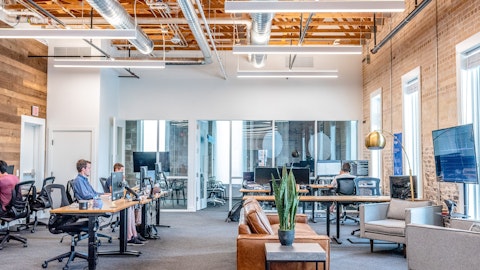IBEX Limited (NASDAQ:IBEX) Q2 2024 Earnings Call Transcript February 8, 2024
IBEX Limited misses on earnings expectations. Reported EPS is $0.44 EPS, expectations were $0.51. IBEX isn’t one of the 30 most popular stocks among hedge funds at the end of the third quarter (see the details here).
Operator: Welcome to the IBEX Second Quarter Full Year 2024 Earnings Conference Call. At this time all participants are in a listen-only mode. After the speakers’ presentation, there will be a question-and-answer session. [Operator Instructions] Please be advised that today’s is being recorded. To note, there is an accompanying earnings deck presentation available on the IBEX Investor Relations website at investors.ibex.co. I will now turn this conference over to Mr. Michael Darwal, Investor Relations of IBEX.
Michael Darwal: Good afternoon, and thank you for joining us today. Before we begin, I want to remind you that matters discussed on today’s call may include forward-looking statements related to our operating performance, financial goals and business outlook, which are based on management’s current beliefs and assumptions. Please note that these forward-looking statements reflect our opinion as of the date of this call, and we undertake no obligation to revise this information as a result of new developments, which may occur. Forward-looking statements are subject to various risks, uncertainties and other factors that could cause our actual results to differ materially from those expected and described today. For a more detailed description of our risk factors, please review our annual report on Form 10-K filed with the U.S. Securities and Exchange Commission on September 13, 2023.
As a reminder, as of July 1, 2023, we became a domestic filer and as such are now reporting on a U.S. GAAP basis rather than from the previous IFRS standard. With that, I will now turn the call over to IBEX CEO, Bob Dechant.
Bob Dechant: Thank you, Mike. Good afternoon, everyone, and thank you all for joining us today as we share our second quarter fiscal 2024 results. Over the course of the last 12 months, we have made strategic investments into our building blocks for our next phase of growth, efforts which are now coming to fruition in terms of size, speed, and quality of our new logo, pipeline, and wins. I am very excited to report we had eight new client wins in the quarter, totaling 12 for the first half of FY2024 as compared to seven for the first half of FY2023. This tracks similarly to the velocity of our new client wins we had in FY2022, our banner year for new logos. These wins include several high-profile deals with Fortune 50 and Fortune 500 clients, opportunities we won head-to-head against our multibillion-dollar competitors.
Beyond this, we have continued to have success with exciting new economy brands. These wins span our strategic verticals of HealthTech and Retail and E-Commerce and AI technology. Stepping back and looking at these deals and our key pipeline opportunities, I am seeing that AI capabilities are playing a key role in client decision-making as they look for BPO partners, who can not only deliver great contact center services, but also rapidly deploy disruptive AI-based solutions. Our recent accomplishments highlight our ability to succeed on both fronts and positions us well as we move forward. This momentum is continuing into our second half with wins and great opportunities with premier brands in Q3. Although our new logo engine continues to build strength for future growth, the combination of softer volumes with several embedded base clients and the transition of significant client volume from our onshore to offshore regions led to lower top-line revenue in the quarter.
Revenues came in at $132.6 million, down 4.8% from prior year. The impact of this, coupled with planned investments in three key areas, including our sales organization, our AI initiative, and our integrated HCM/ERP systems, resulted in a decline in adjusted EBITDA to $14.3 million from $19.4 million in Q2 FY2023. Additionally, we had a $2.3 million adverse impact associated with the recognition of deferred training revenue to both top and bottom line results when comparing to prior year quarter. As previously noted, when we are going through significant ramps for new wins, we defer training revenues associated with those ramps over the term of the program while recognizing the full training costs in the current period. While new client wins and ramps have a long-term positive impact for the business, the initial launches have a short term negative impact.
IBEX continues to optimize its footprint and capacity utilization through a combination of shifting volume mix toward our offshore geographies as well as right sizing our onshore and nearshore footprints. Since the start of the fiscal year, capacity utilization has increased in each of our regions, driven by the combination of shifting mix and the site rationalizations we undertook in the second half of fiscal year 2023. We exited December at 91% utilization of our seat capacity globally, including work-at-home, up from 77% as of June 2023. Our onshore delivery now represents less than 23% of revenue versus 27% same quarter a year ago, and our offshore markets now make up nearly 50% versus less than 43% a year ago. It is these shifts that give us confidence in our expectations for appreciable margin improvement starting in Q3, FY2024.
I would like to spend a few minutes talking about our plan to accelerate our leadership position in deploying AI-based solutions. Recently, we announced the hiring of industry veteran, Eric Guarro as our Senior Vice President of Digital Transformation. In his newly appointed role, Guarro, will spearhead the strategy and execution of IBEX’s digital transformation offering aimed at reshaping customer and brand interactions through the seamless integration of cutting-edge contact center solutions and AI-enabled technologies. This is one of the several strategic investments we continue to make in support of our three axis strategy for deploying AI for our clients to improve performance, cost and the customer experience. Last quarter, I discussed a disruptive solution we are deploying for smart IVRs, conversational chat and voice bots for an important new client win.
With Eric leading the charge, we have developed a robust pipeline across all three axis and we continue to win new opportunities and deployments. As an example, we are implementing a solution for deep AI-driven analytics for a top healthcare company leveraging Anna AI. The goal is to redefine the patient experience by leveraging AI-powered quality and sentiment analysis of every interaction to rapidly identify drivers of dissatisfaction. AI technology also creates opportunities for us on the client front. We are very excited about a new client win with an AI wearables technology pioneer who has developed the first wearable device and software platform to build and harness the full power of AI. We are working shoulder-to-shoulder with our client to bring this product and service successfully to market and to define an amazing customer experience.
It is these exciting wins that showcase our differentiation and our first mover position in AI. From a capital allocation standpoint, we continue to execute on our share buyback program which we announced last September, driven by the current valuation and our confidence in the trajectory of IBEX. Since we announced the program, we have acquired more than 700,000 shares back. This continues to be an attractive and efficient use of our capital. We continue to evaluate new markets for expansion whether organically or through acquisition. We have an enviable net cash position of $48 million, giving IBEX the flexibility to constructively use and make targeted investments for growth. In closing, the BPO industry is at an inflection point where the winners will transform their businesses into higher value solutions powered by AI.

We believe we can be a long-term winner leveraging our speed, flexibility and tech led D&A [ph]. Our early results are encouraging. My team and I remained ever focused on continued strengthening of the business and delivering value for our employees, clients and shareholders. I will now turn the call over to Taylor to go through our financials. Taylor?
Taylor Greenwald: Thank you, Bob, and good afternoon, everyone. Thank you for joining the call today. My discussions of our second quarter fiscal 2024 financial results references to revenue, net income and net cash generated from operations are on a U.S. GAAP basis, while adjusted net income, adjusted earnings per share, adjusted EBITDA, and free cash flow are on a non-GAAP basis. Reconciliations of our U.S. GAAP to non-GAAP measures are included in the tables attached to our earnings press release. Our second quarter results were impacted by softer than anticipated contact volume in some of our embedded base business, as well as the year-over-year impact of the shifting mix from onshore to offshore delivery. These impacts, combined with a changing business environment for several of our FinTech and telecommunications clients, resulted in revenue of $132.6 million, a 4.8% decline compared to $139.3 million in the prior year quarter.
Looking at revenue in total, revenue declines in the FinTech and telecommunication verticals were partially offset by growth in our strategic HealthTech and retail and e-commerce verticals. Revenue mix continued to trend toward digital and omnichannel services and offshore geographies. Digital and omnichannel delivery now represents 79% of our total revenue versus 73% in the second quarter a year ago, while our offshore and nearshore revenues now comprise 77% of total revenue versus 73% in the prior year quarter. We expect that these mix shift trends will have a positive impact on margins over time. Another significant factor in year-over-year revenue was the adverse impact of the recognition of training revenue associated with new client program ramps [ph].
In accordance with U.S. GAAP, revenue associated with training, although billed at the beginning of a new program, is deferred and recognized over the expected life of the program. Deferred training revenue had a 2.3 million adverse impact to revenue when comparing our second quarter with the prior year. Deferred revenue that was recognized in the second quarter was 1.7 million lower than compared to the prior year quarter, while training revenue billed and deferred in the second quarter was 600,000 higher than the prior year quarter. This not only impacted revenue but also negatively impacted gross margin comparisons versus the prior year. Gross margin was 27.7% versus 28.4% in the prior year. Normalizing for this deferred training revenue impact, gross margin was up roughly 100 basis points from the prior year, reflecting improvement from our increasing offshore revenue mix.
Net income was $6.1 million compared to $9.3 million in the prior year quarter. The decrease was primarily a result of the impact of deferred training revenue previously discussed, as well as our strategic investments in our technology, including HCM and ERP infrastructure, and our sales and marketing organizations. These investments are important pieces of our strategy to drive and support growth in our business. Our tax rate for the quarter was 17% compared to 18% last year. We expect the tax rate to remain in the high teens for the fiscal year. Fully diluted EPS was $0.33 compared to $0.49 in the prior year quarter. On a non-GAAP basis. adjusted net income was $8 million compared to $12.2 million in the prior year quarter. Non-GAAP fully diluted adjusted earnings per share were $0.44 compared to $0.65 in the prior year quarter.
Adjusted EBITDA was $14.3 million or 10.8% of revenue compared to $19.4 million or 13.9% of revenue for the same period last year. The change in adjusted EBITDA margin was primarily driven by the accounting for deferred train revenue as well as investments in our technology, including HCM and ERP infrastructure, and our sales and marketing organizations in support of our strategic vertical growth strategy. For the second quarter of fiscal year 2024, our top five, top ten and top 25 client concentrations remain largely flat at 41%, 59% and 82%, respectively of overall revenue representative of a well diversified client portfolio. Switching to our verticals, retail and ecommerce increased to 29.0% of second quarter revenue versus 26.9% in the prior year quarter.
Health tech increased to 12.2% of second quarter revenue versus 8.7% in the prior year quarter, and travel, transportation and logistics increased to 12.5% of second quarter revenue versus 11.4% in the prior year quarter. Conversely, our exposure to the telecommunications vertical decreased to 14.8% of quarterly revenue versus 16.7% in the prior year quarter. Additionally, FinTech decreased to 13.7% of revenue for the quarter versus 19.2% in the prior year quarter, impacted by the changing landscape for crypto and new economy investment platform clients. Net cash generated from operating activities was a negative $1.6 million for the quarter compared to a positive $5.3 million in the prior year quarter. For the first half of our fiscal year, operating cash flow was a positive $7 million versus $10.9 million.
Our DSOs were 73 days, up from 67 days at the end of the first quarter and in line with industry average. Several larger client payments were received in the first week of January and negatively impacted DSOs at the end of the second quarter. Capital expenditures were $2.9 million, or 2.2% of revenue in the second quarter of fiscal year 2024 versus $7.9 million, or 5.7% of revenue in the prior year quarter as we continued to utilize our available capacity from build outs completed in previous years. Free cash flow decreased to a negative $4.5 million in the current quarter compared to a negative $2.7 million in the prior year quarter due to lower income from operations and higher DSOs. For the first half of our fiscal year, free cash flow was a positive $2.1 million versus a negative $700,000 in the prior year.
We ended the second quarter with $49 million in cash, down from $57.4 million as of June 2023 driven by share repurchases during the quarter. Net cash was $48.0 million, down from $56.4 million as of June 2023. We continued with our share repurchase program announced on September 18, 2023 authorizing us to repurchase up to $30 million worth of shares. During the second quarter, we repurchased 489,000 shares for $8.4 million. For fiscal year-to-date through January 31, 2024 we’ve repurchased 740,000 shares for a total cost of $12.5 million. Looking forward to the remainder of 2024, we expect softness in some of our client volumes to continue for the near term and therefore expect third quarter revenues to trend similarly as the first two quarters on a year-over-year basis.
As our new client ramps reach scale in the fourth quarter, we anticipate an inflection towards growth. We remain confident that our strategy of driving growth in our higher margin offshore regions, accelerated by our new client wins and realizing cost savings through optimizing our site footprint will drive improvement in adjusted EBITDA margins for the second half of our fiscal year and in the years ahead. As a result of these factors, we are updating our full year guidance. On a full year basis, we expect revenues to be between $505 million and $510 million and adjusted EBITDA margin in the range of 12% to 13%. We feel strongly in our overall business fundamentals and the differentiated value proposition we bring our clients. We remain excited about our business and believe our recent client wins, strength of our pipeline and strategic investments will position us well as we move forward.
With that, Bob and I will now take questions. Operator, please open the line.
See also 11 Best Gold Stocks For Inflation and 10 Dividend Stocks That are On Sale 30% or More.
Q&A Session
Follow Ibex Ltd (NASDAQ:IBEX)
Follow Ibex Ltd (NASDAQ:IBEX)
Operator: Thank you. [Operator Instructions] Our first question comes from the line of David Koning from Baird.
David Koning: Yes. Hey guys, thanks for all the details. And maybe first of all the FinTech segment I was just looking at, it looked like it was down about 30% year-over-year. You talked a little bit about what happened there. That was really the entire decline of the total company is just that piece, really and the rest seemed to do quite a bit better. Maybe just go through a little more of what that was?
Bob Dechant: Sure, David, and thanks for joining and thanks for the question. So in the FinTech side we have had some crypto client as well as a kind of a new economy, millennial trading app partner client. And both of those, their businesses have been impacted really with kind of the economy, the crypto markets, et cetera, so those are down. On the other side of the equation I would look and say that a lot of the various verticals, there’s winners, there’s losers and so when we talked about where the softness came in, it wasn’t really, aside from that FinTech’s [indiscernible], there were winners, losers kind of across the various verticals. So we kind of like that as an overall macro that it’s like, look one segment isn’t – our biggest segments aren’t really moving down. And so we have winners, losers around those some that are down, some of them that are deploying various call shedding solutions that are putting some pressure on various volumes.
David Koning: Got you. Yes, No , that that makes sense. And then the utilization was actually quite good, like maybe one of the best you’ve ever had, but yet margins were a little weak. What’s the dynamic there? I know it’s going to get quite a bit better yet, but what’s the dynamic there?
Bob Dechant: Yes, great question. And let me start out with, and Taylor, if you feel like adding feel free to do that. But the biggest starts with the deferred training impact in the quarter. So that took top line, but all the way down to the bottom line, $2.3 million. So that was if you look at then the margins on an EBITDA basis, certainly that had a large impact. What’s interesting in what Taylor shared, if you normalize for that, our gross margins actually, they went up 100 basis points. And now that we kind of have that in our rear view mirror, some of those large ramps, that’s why we feel like running where we are from the percentage of business in our offshore, our near-shore and running at the high utilizations. We feel really confident about the margin strengthening significantly in the second half.
David Koning: Gotcha. That makes sense. And maybe just, if I – oh Taylor is going to jump in. Yes, sorry, go ahead.
Taylor Greenwald: No, I was just going to just confirm that the underlying gross margins we feel very good about, they remain healthy. As Bob said, they were up roughly 100 basis points when you adjust for the deferred train revenue. And then as we look forward, we see some new wins in the higher margin regions, which are going to help propel our margins were going to. We have some specific site and region initiatives to drive the contribution margin in a couple of spots, and we’re already starting to see those bear fruit. And then, as Bob mentioned we’re going to continue to look at our footprint and we see some opportunities there as well. So we feel good about where our margins are and where they’re going to head.
David Koning: Yes that – now that’s great. And if I can just sneak one more, can you explain one more time? I heard you say $1.7 million lower training revenue and then a $600,000 cost that added up to $2.3 million. Why did the training revenue go down so much year-over-year when it should just be kind of ratable recognition?
Taylor Greenwald: Yes. So the way the accounting works when train revenue is built, it’s built at the beginning of a program, but it’s recognized over the life of the program. So if you look at last year versus this year, the way the amortization or the deferred revenue recognition schedules worked out, we recognized about $1.7 million of that revenue that has no cash associated with it, cash is all received up front. And then this year, because we won some new logos recently and actively ramping some new programs, we deferred an additional $600,000 versus the prior year. So you’ve got net those two together, and you can see the $2.3 million adverse impact to our financials. And I can also point you, if you look at our Q in footnote 2, at the end of footnote 2, there is a detailed schedule of our deferred revenue that helps provide some insight into that as well.
David Koning: Awesome. Bob, thanks so much for all that.
Operator: Thank you. One moment for our next question. Our next question comes from the line of Tobey Sommer from Truist Securities.
Jack Wilson: Yes, hi, thanks for taking my question. This is Jack Wilson on for Tobey. So I sort of just to follow-up on that margin question. Do we expect to see sort of any cadence for the margin through the remainder of the year? Do we expect that to sort of ramp up? Or is it going to be a little more varied?



